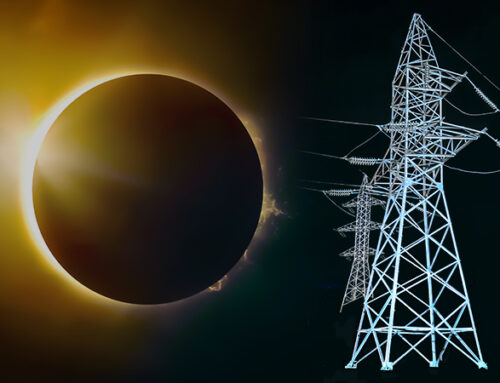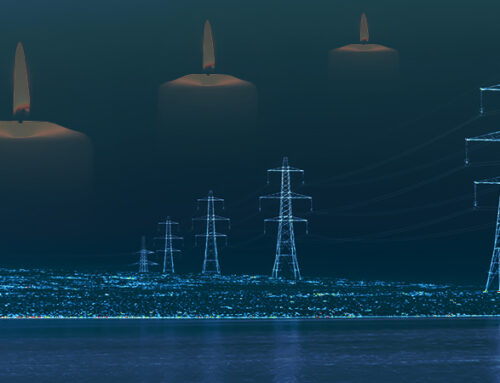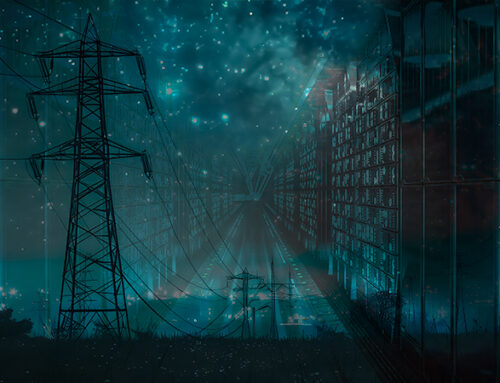The importance of security of supply has been underlined this week by events in the US state of Texas which has been hit by extensive power outages as unprecedented cold weather saw temperatures fall as low as -22 oC, leaving millions of homes without power. Brownsville, Texas saw snowfall for just the second time since 1898. Wholesale power prices broke through the market’s $9,000 /MWh price cap to settle at $9,009.40 /MWh, in the West hub at 1 am in Houston, a staggering 3,466% increase from Friday.
The issue is not just affecting electricity supplies, oil refineries have been forced to close and restrictions have been placed on gas pipeline operators.
Alongside the inevitable claims that this is climate change in action, the situation has illustrated something which is often forgotten: the most important leg of the energy trilemma (affordability, de-carbonisation and security of supply) is security of supply by some distance. We take for granted that when we hit the switch, the lights come on, but if you find in the literal depths of winter that neither your lighting nor heating can come on, this is not just an inconvenience, it is a major health risk.
“They have been in the car all day with the heater on…The inside of their home has dropped below 40 degrees,”
– Texas resident speaking about his family
Those of us that live at the edge of the grid (our house is the last house on both the electricity and gas networks, and we have no water connections) are aware that our supplies may be less resilient, and therefore plan accordingly. We have a battery that can run our sewage pump and a generator that could both charge the battery and keep essential appliances such as the freezer running. We have open fires and wood burners and various storm lamps and candles. Losing our electricity and or gas supplies would be inconvenient, and definitely not pleasant in winter, but we would manage.
But most people don’t live at the grid edge, and therefore don’t plan for outages. They may have a few candles lying around, but not much else. In Texas, people were advised to boil their water since a water treatment plant had lost power, without considering that this might be difficult in the middle of a blackout.
So what actually happened?
 The situation began when severe cold weather hit large parts of the US and caused temperatures to plummet. This had two effects: demand rose sharply, exceeding the previous record by around 3.4 GW, while at the same time, a large amount of generating capacity went offline.
The situation began when severe cold weather hit large parts of the US and caused temperatures to plummet. This had two effects: demand rose sharply, exceeding the previous record by around 3.4 GW, while at the same time, a large amount of generating capacity went offline.
The Texan electricity grid was designed with high summer demand in mind, when air conditioning use is high. Some of the generators that power the grid during the summer are offline during the winter, while others were knocked out by the extreme cold weather, due to ice build-up on key equipment and severe disruptions to gas pipeline supplies. Covid pandemic measures as well as the cold weather kept people indoors, boosting electricity demand to record levels, at which point the grid was unable to cope and a series of rolling blackouts was implemented.
“Beginning around 11:00 p.m. [Sunday night], multiple generating units began tripping off-line in rapid progression due to the severe cold weather,”
– Dan Woodfin, senior director of system operations at ERCOT“We are experiencing record-breaking electric demand due to the extreme cold temperatures that have gripped Texas. At the same time, we are dealing with higher-than-normal generation outages due to frozen wind turbines and limited natural gas supplies available to generating units,”
– Bill Magness, President and CEO of ERCOT
 According to Jesse Jenkins, assistant professor at Princeton University with a joint appointment in the Department of Mechanical and Aerospace Engineering and the Andlinger Center for Energy and Environment, at once point yesterday, around 30 GW of capacity was offline: 26 GW of thermal – mostly natural gas which saw restricted fuel deliveries due to a mixture of frozen pipelines and gas being diverted for heating, and 4 GW of wind due to icing. (Other sources claimed that about half of the state’s 25 GW wind capacity was offline.)
According to Jesse Jenkins, assistant professor at Princeton University with a joint appointment in the Department of Mechanical and Aerospace Engineering and the Andlinger Center for Energy and Environment, at once point yesterday, around 30 GW of capacity was offline: 26 GW of thermal – mostly natural gas which saw restricted fuel deliveries due to a mixture of frozen pipelines and gas being diverted for heating, and 4 GW of wind due to icing. (Other sources claimed that about half of the state’s 25 GW wind capacity was offline.)
This meant that around half of the gas fleet was offline, representing about 30% of total system capacity. However, ERCOT’s winter planning assumes 100% thermal plant availability in winter peaks, the loss of which is a major cause of the current blackouts.
The precise reasons for all of the outages are not yet available, but a report from a previous cold snap in 2014 suggested a range of causes, from natural-gas pipelines freezing up to the failure of plant safety equipment.
Temperatures this week have been low enough to trigger so-called freeze-offs, when wells shut down and pipeline use is restricted due to liquids freezing inside gas pipelines. Texan facilities operated by pipeline companies DCP Midstream LP and Targa Resources were reportedly shut on due to the cold. Gas utility Enbridge said it was limiting requests to transport gas on a pipeline from Texas to New Jersey.
 As the shortages emerged, large industrial users with interruptible supply agreements were disconnected, but the situation deteriorated rapidly, requiring rotating outages for all consumers across much of the state. Almost 34 GW of generating capacity was offline at one point, which is higher than the summer peak demand for the whole of GB, and 10.5 GW of customer load was shed. But even with planned load shedding, the system struggled to cope, with system frequency struggling to reach 60 Hz (the US system operates at a higher frequency than the UK which runs at 50 Hz).
As the shortages emerged, large industrial users with interruptible supply agreements were disconnected, but the situation deteriorated rapidly, requiring rotating outages for all consumers across much of the state. Almost 34 GW of generating capacity was offline at one point, which is higher than the summer peak demand for the whole of GB, and 10.5 GW of customer load was shed. But even with planned load shedding, the system struggled to cope, with system frequency struggling to reach 60 Hz (the US system operates at a higher frequency than the UK which runs at 50 Hz).
Alongside the obvious impact of the outages, the effect on one group of consumers is particularly hard: those exposed to spot market prices. A company called Griddy offers its customers wholesale price linked tariffs – some of its customers are facing $1,000-$2,000 costs for just this week, and are struggling to pay.
Another supplier called Volt has apparently been offering its customers incentives to switch to other suppliers, while others are encouraging customers to reduce consumption by a variety of means including entering them into a draw for a Tesla car if they cut usage by 10%. Whether or not consumers will be able to switch is another matter with reports that suppliers are unwilling to take on new customers before Wednesday when the weather is set to improve.
(This issue was discussed in this excellent overview of the situation by Paul McArdle of Watt-Clarity, who also carried a guest blog on his site recently describing a consumers experience of spot price exposure, both of which are worth reading.)
This is not the first time cold-related blackouts have hit Texas
In August 2011, six months after an ice storm crippled caused similar rotating outages in the state, the Federal Energy Regulatory Commission and the North American Electric Reliability Corporation issued a report into the causes of the blackouts:
“Generators and natural gas producers suffered severe losses of capacity despite having received accurate forecasts of the storm. Entities in both categories report having winterisation procedures in place. However, the poor performance of many of these generating units and wells suggests that these procedures were either inadequate or were not adequately followed.”
According to the investigation, the 2011 outages were preceded by similar events in 1989, the first time ERCOT ever implemented rotating outages:
“The experiences of 1989 are instructive, particularly on the electric side. In that year, as in 2011, cold weather caused many generators to trip, derate, or fail to start. The [Public Utility Commission of Texas] investigated the occurrence and issued a number of recommendations aimed at improving winterization on the part of the generators. These recommendations were not mandatory, and over the course of time implementation lapsed. Many of the generators that experienced outages in 1989 failed again in 2011.”
“Winterising” equipment to ensure it can sustain extended periods of below-freezing temperatures has never been a requirement in Texas as it is in other states, but with such outages only happening roughly every decade there is a question over whether the costs are justified.
In 2019 Great Britain experienced a once-in-a-decade blackout, and the same questions were raised (including by me), and while I believe the definition of SQSS should be amended to take into account co-incidental losses of embedded generation, I believe caution is appropriate when it comes to the cost of protecting against such rare events. But the Texan situation is not the same because the cause of its once-in-a-decade outages is severe cold weather that presents a significant danger to public health (extreme cold temperatures can be lethal) and safety (increased risk of accidents due to frozen roads). Many vulnerable inhabitants of the state live in poorly insulated homes, and are particularly at risk.
Texan lawmakers now have a few years to decide how to address this risk, but improving Texan homes and their energy resilience might be as worthwhile as making generating equipment cold-proof, since this would have wider system benefits.
Importance of security of supply
The importance of security of supply was explicitly recognised on 14 February when ERCOT asked the Energy Secretary to authorise all power plants in its area to run at full capacity, “notwithstanding air quality or other permit limitations”. The letter goes on to explain that a number of generators in the State had contacted ERCOT to inform it that their ability to continue running was at risk due to operating restrictions that restrict emissions, but that in the system operator’s view, breaching these restrictions was the lesser of two evils:
“However, in ERCOT’s judgment, the loss of power to homes and local businesses in the areas affected by curtailments presents a far greater risk to public health and safety than the temporary exceedances of those permit limits that would be allowed under the requested order.”
The letter identified around 100 affected power plants.
The read across to the UK is limited by a number of factors, not least that ERCOT is an energy-only market where there are no explicit payments for capacity but it does provide a useful reminder that security of supply can and does over-ride the other elements of the trilemma. And it should not be assumed that the situation in Texas could not be repeated here: this week GB also saw very low temperatures (-23oC in Scotland), and this winter the British system has been unusually tight. As the weather warms up, we should avoid complacency and ensure that electricity system resilience is not compromised during the energy transition.






Hi Kathryn……could it be said that the effects of COVID-19 here in the Uk are a dampening factor on demand ?
Have/are we getting away with it due to industry not operating at full capacity ?
We all remember those winter weekday, late afternoon evening peaks with everything on the edge.
Fingers crossed that the network held up devoid of faults.
Power plants controlled by hands on throttles, direct dialogue & maximum co-operation.
Brilliant enthusiastic staff “All in it together” keeping the lights on.
I recall a line engineer heading to a christmas gathering with his wife when he received an emergency call.
He returned back home, dropped her off.
His wife didn’t see him for several days after the event.
Barry Wright, Lancashire.
I’ve had a look at Q1 demand for the past 3 years and so far this year is not lower than the previous two years. I think the fact it has been colder has offset the covid effect with lower industrial demand offset by higher heating demand, so possibly if industrial demand was normal then we would have seen a lot more tightness this winter.
Kathryn, I see you have picked up many of the same points as me … and have also been watching Texas with great interest from afar:
https://wattclarity.com.au/articles/2021/02/texas-loadshedding/
Hi Paul – indeed, I read your post with interest and have linked to it above (and your guest post on spot-linked retail tariffs, which was also very interesting). I’m in awe at the number and detail of your posts…I know how time consuming it is to pull them together…you must never sleep!
High Kathryn….further to an excellent posting I quote from above, particularly the comment referring to the Texas situation occurring here in the UK:
“The read across to the UK is limited by a number of factors, not least that ERCOT is an energy-only market where there are no explicit payments for capacity but it does provide a useful reminder that security of supply can and does over-ride the other elements of the trilemma. And it should not be assumed that the situation in Texas could not be repeated here: this week GB also saw very low temperatures (-23oC in Scotland), and this winter the British system has been unusually tight. As the weather warms up, we should avoid complacency and ensure that electricity system resilience is not compromised during the energy transition”
I just couldn’t resist to provide the following account of events on trans pennine supergrid overhead lines from February 1986:
https://www.youtube.com/watch?v=QLl9NCJvZjw
Watch & wonder !……….Barry Wright Lancashire.
That video is amazing – thanks for sharing!
Watching those insulators undulating, and seeing the damage to the towers. It was also pretty amazing to see the men underneath one of the towers discussing lashing the disconnected line – I’d want to stay far out of range in those winds!
Re: customers being directly exposed to wholesale spot prices, this is exactly why Octopus’ ToU tariff has a max price. That’s a service the customers pay for through higher rates on average but worth it to let them hedge for you while still making use of load shifting if you can. Not a great idea to allow unsophisticated buyers access to completely uncapped markets because they won’t be able to / know they should hedge their exposure.
The guy who wrote the blog I link to above about his own experiences of these tariffs in Australia makes the same point – he would not have signed up unless there was a cap on his exposure. He did bemoan the lack of ability to participate in negative pricing…the Octopus Agile T&Cs are silent on negative pricing, presumably because of the size of the non-wholesale component of the tariff.
I think suppliers take a risk in offering domestic consumers unlimited price exposure – large consumer losses and debt issues will attract accusations of mis-selling…
Apparently Octopus Agile did go negative for a while in March last year: https://octopus.energy/blog/social-distancing-renewable-energy-negative-pricing/ It’s less negative than actual wholesale for the reasons you say (although on a HH meter your DUoS tariffs are also ToU they’re not dynamic and this was mostly in the middle of the day). It’s happened before in December 2019 which was overnight so even lower DUoS chargeable then.
Personally I don’t think regulators should permit domestic customers to have access to completely uncapped tariffs. There’s two kinds of customers: the majority who wouldn’t know the dangers of signing up for an uncapped tariff, and people like the Australian guy who quite rightly wouldn’t sign up to an uncapped tariff.(I guess technically a third kind might sign up but hedge their own exposure but then you’re not a domestic customer and there’s no way you could hedge as cheaply as a large supplier) I’m not usually a big fan of outright bans but this is basically a product that only the uninformed would buy and I generally think that society progresses by keeping things like energy boring not creating exciting opportunities for domestic customers and small business owners to engage in energy market operations.
I’m not clear whether regulators in the UK could even prevent an uncapped tariff but as you say, they would run the real risk of post-hoc action and of customers being unable to pay anyway.
The most fundamental problem for ERCOT was that they went into this crisis with inadequate amounts of dispatchable capacity. Even if no plant had tripped, they would have been enforcing at least 4GW of power cuts on their own estimate as revealed when they appealed for dispensation on emission limits. They had allowed too much of it to be simultaneously in maintenance (over 20GW), and by the time the problem loomed up they were unable to claw much of it back. Their planning also foolishly assumed an effective capacity of 6GW for wind. In the event, and surely no surprise given how often it happens in winter and summer, there were several points where wind production was running well under 1 GW (including peak demand hour as would have been on the 15th) simply because the wind died – never mind the icing.
https://weatherspark.com/h/d/145759/2021/2/15/Historical-Weather-on-Monday-February-15-2021-at-Lubbock-International-Airport-Texas-United-States#Figures-WindSpeed
I have always found National Grid’s assumptions about this to be hopelessly optimistic, and indeed, they got caught out the same way several times over the winter to date.
How did they get there? Roger Pielke captured the essence of that here:
https://rogerpielkejr.substack.com/p/the-texas-blackout-and-preparing
They had ignored 1989. They had swallowed the global warming pill. They assumed there wasn’t going to be the problem. Which reminds me of FES 2020, the White Paper, and the Sixth Carbon Budget. If there might be a problem like this event, simply assume it doesn’t exist, and in fact assume that things will never be anywhere near as difficult.
Don’t worry that heat pumps revert to resistive heating when it gets really cold, sending demand skyrocketing. Be happy when the wind doesn’t blow enough and your backup capacity is struggling to meet demand – and then a plant trip sends frequency into freefall because you have no reserve left, tripping out many other generators and rapidly dumping you into massive amount of load shedding – partly because you failed to shed load until the frequency hit the automated levels – in this case 59.3Hz at 1:52 a.m.
http://web.archive.org/web/20210215075245/http://www.ercot.com/content/cdr/html/real_time_system_conditions.html
Don’t be surprised that having cut power to gas pipeline compressors and water pumping as part of the shedding, power stations start running short of gas and cooling and steam water – forcing more of them offline – even though LNG liquefaction plants have released 4bcf/day back to the market netting a large profit to pay vessel demurrage while they wait for cargo. These are just the details.
https://www.yesenergy.com/yeblog/2021/generation-role-ercot-cold-snap
Plan to solve the problem by doubling wind capacity, pushing the market into regular surplus with close to zero or negative prices that mean no plant earns a return, and that dispatchable capacity erodes, creating more extreme price volatility and similar shortages and blackouts. And because you have kicked off so much inertia, don’t be surprised when frequency overshoots the automated trip levels into system black territory. You were heroically supporting the US effort in rejoining the Paris accord.
https://cleantechnica.com/2021/02/20/texas-to-add-35-gigawatts-of-wind-solar-in-next-3-years-boosting-grid-resilience/amp/
This is the way to go:
https://www.startribune.com/top-board-leaders-resign-after-deadly-texas-power-outages/600026547/
But the real culprits are those who push the fiction that they didn’t need to worry about the real world in the first place – only the model one.